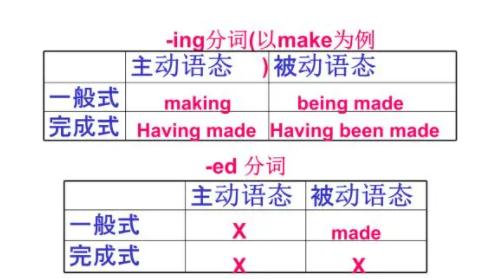本文目录
什么是现在分词
)过去时表示过去某时发生的动作或单纯叙述过去的事情,强调动作;现在完成时为过去发生的,强调过去的事情对现在的影响,强调的是影响。
2)过去时常与具体的时间状语连用,而现在完成时通常与模糊的时间状语连用,或无时间状语。
一般过去时的时间状语:
yesterday, last week,…ago, in1980, in October, just now, 具体的时间状语
共同的时间状语:
this morning, tonight,this April, now, once,before, already, recently,lately
现在完成时的时间状语
for, since, so far, ever, never, just, yet, till / until, up to now, in past years, always,
不确定的时间状语
3)现在完成时可表示持续到现在的动作或状态,动词一般是延续性的,如live, teach, learn, work, study, know.
过去时常用的非持续性动词有come, go, leave, start, die, finish, become, get married等。
举例:
I saw this film yesterday.
(强调看的动作发生过了。)
I have seen this film.
(强调对现在的影响,电影的内容已经知道了。)
Why did you get up so early?
(强调起床的动作已发生过了。)
Who hasn't handed in his paper?
(强调有卷子,可能为不公平竞争。)
She has returned from Paris.
她已从巴黎回来了。
She returned yesterday.
她是昨天回来了。
He has been in the League for three years.
(在团内的状态可延续)
He has been a League member for three years.
(是团员的状态可持续)
He joined the League three years ago.
( 三年前入团,joined为短暂行为。)
I have finished my homework now.
---Will somebody go and get Dr. White?
---He's already been sent for.
句子中如有过去时的时间副词(如 yesterday, last, week, in 1960)时,不能使用现在完成时,要用过去时。
(错)Tom has written a letter to his parents last night.
(对)Tom wrote a letter to his parents last night.
过去完成时
1) 概念:表示过去的过去
----|-------|-----|---->其构成是had +过去分词构成。
那时以前 那时 现在
2) 用法
a. 在told, said, knew, heard, thought等动词后的宾语从句。
She said (that) she had never been to Paris.
b. 状语从句
在过去不同时间发生的两个动作中,发生在先,用过去完成时;发生在后,用一般过去时。
When the police arrived, the thieves had run away.
c. 表示意向的动词,如hope, wish, expect, think, intend, mean, suppose等,用过去完成时表示"原本…,未能…"
We had hoped that you would come, but you didn't.
3) 过去完成时的时间状语before, by, until , when, after, once, as soon as。
He said that he had learned some English before.
By the time he was twelve, Edison had began to make a living by himself.
Tom was disappointed that most of the guests had left when he arrived at the party.
典型例题
The students ___ busily when Miss Brown went to get a book she ___ in the office.
A. had written, left B,were writing, has left C. had written, had left D. were writing, had left
答案D. "把书忘在办公室"发生在"去取书"这一过去的动作之前,因此"忘了书"这一动作发生在过去的过去,用过去完成时。句中when表示的是时间的一点,表示在"同学们正忙于……"这一背景下,when所引导的动作发生。因此
前一句应用过去进行时。
注意: had no … when 还没等…… 就……
had no sooner… than 刚…… 就……
He had no sooner bought the car than he sold it.

什么时候用现在分词什么时候用过去分词例子
什么时候用现在分词什么时候用过去分词?现在分词和过去分词主要差别在于:现在分词表示"主动和进行",过去分词表示"被动和完成"(不及物动词的过去分词不表示被动,只表示完成).分词可以有自己的状语、宾语或逻辑主语等.
1、 分词作状语分词在句子中作状语,可以表示时间、条件、原因、结果、让步、伴随等.
分词在句子中作状语,使用何种分词,要取决于分词与句子主语的关系:主谓关系用现在分词,动宾或被动关系用过去分词.
(1)现在分词The students went out of the classroom, laughing and talking.
(2)过去分词Accompanied by his friend, he went to the railway station. Given better attention, the plants could grow better.
2、"while ( when, once, until, if , though等连词)+分词"结构现在分词或过去分词作状语时,有时可以在分词前加while,when, once, although, until, if等连词.
When leaving the airport, she waved again and again to us. While waiting for the train, I had a long talk with my sister about her work……
Once recovered, he threw himself into his work and made every effort to do it well.
Although working very hard, he failed to pass the final exam. If translated word by word, the passage will be difficult to understand.
3、分词作定语分词作定语时,单个的分词通常放在被修饰的名词之前,分词短语一般置于所修饰的中心词后面.现在分词修饰的是发出该动作的名词(即与名词有主谓关系),过去分词修饰承受该动作的名词(即与名词是动宾关系).
We will go on with our experiment as soon as we get the added fund.
This is really an exhausting day to all of us!
We can see the part of the moon lighted by sunlight.
After a night spent in excitement and sleeplessness, I forced myself to take a long walk along the beach the next day.
More and more developing countries established strategic partnership with developed countries
4、分词作宾语补足语现在分词在see, watch, hear, observe, notice, feel, find, glimpse, glance等感官动词和look at, listen to等短语动词以及have, keep, get, catch, leave, set, start, send等使役动词后面与名词或代词构成复合宾语,作宾语补语的成分.
5、分词作表语分词作表语通常看作形容词来用.现在分词表示主语的性质,而且主语多为物;过去分词表示主语的感受或状态,主语多为人.

什么时候用现在分词
现在分词是doing形式,过去分词是done形式。一般来说doing用在进行时态,而done用在过去时态或者被动语态。但是在某些固定搭配上不同,比如enjoy doing,have fun doing,而带done的一般表示被动

现在分词在什么时候用
现在分词在现在进行时的时候用。
作用:现在分词(present participle)(又称-ing形式,现在进行时),是分词的一种,分词又分为现在分词和过去分词,它们都是非限定动词。
怎么用:现在分词在句子里面不能单独充当谓语,但能充当其它的一些成分(定语,表语,补语,状语),并且它们具有动词的性质。

否定结构
现在分词的否定式由“not+现在分词”构成。如:
Not knowing where to go, she went to the police for help.
她不知道该往哪儿走,就去请警察帮助。(现在分词一般式的否定结构)。
Not seeing John, I asked where he was.
我看不见约翰,于是问他在何处。(现在分词一般式的否定结构)。
以上就是关于什么时候用现在分词 ,什么是现在分词的全部内容,以及什么时候用现在分词 的相关内容,希望能够帮到您。

